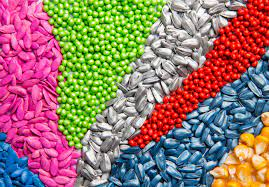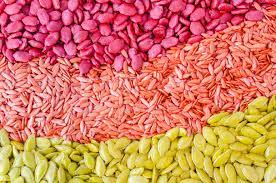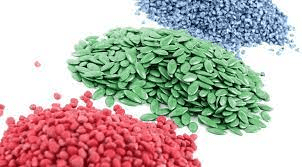In agriculture and horticulture, seed treatment or seed dressing is a chemical, typically antimicrobial or fungicidal, with which seeds are treated (or “dressed”) prior to planting. Less frequently, insecticides are added.
Seed treatments can be an environmentally more friendly way of using pesticides as the amounts used can be rather small. Using specific products and specific techniques can improve the growth environment for the seed, seedling, and young plant.
Seed dressing is the most common method of seed treatment. The seed is dressed with either a dry formulation or wet treated with a slurry or liquid formulation of the seed treatment chemicals. Seed treatment is a term that describes both products and processes while seed dressing is the process.
Read Also : Proper Methods of Storage and Handling of Animal Feedstuffs
Procedure for Seed Dressing /Treatment

There are several pre-sowing treatments which are used for agricultural seeds, including the application of pesticides for the control of soil or seed borne pathogens, modification of seed shape/size and pre-germination before sowing
1. Seed dressing
This is the most common method of seed treatment. The seed is dressed with either a dry formulation or wet treated with a slurry or liquid formulation. Dressings can be applied at both farm and industries.
Low cost earthen pots can be used for mixing pesticides with seed or seed can be spread on a polythene sheet and required quantity of chemical can be sprinkled on seed lot and mixed mechanically by the farmers.
2. Seed coating

A special binder is used with a formulation to enhance adherence to the seed. Coating requires advanced treatment technology, by the industry.
Seed coating or film coating is a technique by which additives such as pesticides, nutrients or nitrifying bacteria can be applied to the seed’s external surface (i.e. the testa). But in contrast to pelleting, the coating conforms to the seed shape and does not normally modify the seed shape.
A film forming polymer containing the required active ingredient is sprayed onto the seeds while they are suspended in a column of air, which is either heated or unheated. A colouring agent is added and the coating material dry quickly resulting in free flowing coated seed.
3. Seed pelleting
The most sophisticated Seed Treatment Technology, resulting in changing physical shape of a seed to enhance palatability and handling. Pelleting requires specialized application machinery and techniques and is the most expensive application.
Pelleting facilitates the manual and mechanical handling of seeds that are either small or awkwardly shaped seed. Individual seeds are encased in an inert material such as montmorillonite clay. Pelleting materials can also be used to incorporate pesticides or form a coating for seed dressing.
Thermal seed treatment
Thermal seed treatments have been one of the earliest seed treatments used in agriculture. They may be based on warm water (45 °C, 2 h), hot-water treatments (52 °C, 10 min) and/or hot air/steam treatments.
Warm or hot water treatments were shown to prevent/reduce Fusariumdisease development effectively often showing similar efficiency to chemical seed dressing
Essential oils
The need for organic treatments to replace the use of disallowed chemicals treatments which had become with orthodox seeds has been indicated with the use of essential oils and organic acids. This is recommended under organic agriculture.
Read Also : How to treat Ruminant Animal Diseases
Advantages and Disadvantages of Seed Dressing

Advantages of seed dressing
It prevents further growth of pathogens that might have adhered to the seed for sowing.
It protects the sown seed and seedling from acquiring soil borne diseases.
It ensures even germination and uniform growth.
It facilitates microbial inoculation for nodulation in leguminous crops.
Disadvantages of seed dressing
Most of the techniques/methods are beyond the capability of our farmers. For instance, the coating and pelleting techniques.
Treated seeds are more costly thus increasing of the cost of production.
Treated seeds are poisonous and not good for consumption. This creates room for wastage of seeds.
Domestic animals and children are at risk in the presence of treated seeds.
Recommendation of seed treatments for crops
| Crop | Pest/Disease | SeedTreatment | Remarks | |
| Sugarcane | Root rot, wilt | Carbendazim (0.1%) 2 g/kg seed Trichodermaspp. 4-6 g/kg seed | For seed dressing metal seed dresser/earthen pots or polythene bags are used. | |
| Rice | Root rot disease | Trichoderma5-10 g/kg seed (before transplanting) | -do- | |
| Other insects/pests | Chloropyriphos 3g/kg seed. | -do- | ||
| Bacterial sheath blight | Pseudomonasfluorescens0.5% W.P. 10 gm/kg. | -do- | ||
| Root knot nematode | Seed soaking in 0.2% of Monocrotophos for 6 hours | -do- | ||
| White tip nematode | Seed soaking in 0.2% solution of Monocrotophos | -do- | ||
| Chillies | Anthracnose spp. Damping off | Seed treatment with Trichodermaviride4g/kg, Carbandazim @ 1g/100 g seed. | -do- | |
| Soil borne infection of fungal disease | Trichodermaviride@ 2 gm/kg. seed and Pseudomonasflourescens,@10g/kg,Captan 75 WS @ 1.5 to 2.5 g a.i./litre for soil drenching. | -do- | ||
| Jassid, aphid, thrips | Imidacloprid 70 WS @ 10- 15 gm a.i./kg seed | -do- | ||
| Pigeon pea | Wilt, Blight and Root rot | Trichodermaspp. @ 4 g/kg. seed | For seed dressing metal seed dresser/earthern pots or polythene bags are used. | |
| rot | BacillussubtilisPseudomonasfluorescens Soil application @ 2.5 – 5 kg in 100 kg FYM or Carbendazim or Captan 2 g/kg seed | |||
| White rot | Thiram + Carbendazim 2 g/ kg seed Carbendazim or Captan 2 g / kg seed | -do- | ||
| Tomato | Soil borne infection of fungal disease. Early blight Damping off Wilt | T.viride@ 2 g/100gm seed. Captan 75 WS @ 1.5 to 2.0 g a.i./litre for soil drenching. Pseudomonasfluorescensand V.clamydosporium@ 10g/kg as seed dresser. | For seed dressing metal seed dresser/earthern pots or polythene bags are used. | |
| Leguminous Vegetables | Soil borne infection | Trichodermaviride@ 2 gm/100g seed. | -do- | |
| Nematode | Carbofuran/Carbosulfan 3% (w/w) | -do- | ||
| Bunt/False smut/loose smut/covered smut | Thiram 75% WP Carboxin 75 % WP Tebuconazole 2 DS @ 1.5 to 1.87 g a.i. per kg seed. T.viride1.15 % WP @ 4 g/kg. | -do- | ||
| Cruciferous vegetables | Soil / Seed borne diseases (Damping off) Root knot nematode | Seed treatment with Trichodermaviridi@ 2 g / 100 g seeds Captan 75% WS @ 1.5 to 2.5 g a.i./litre for soil drenching. Pseudomonasfluorescensand Verlicilliumclamydosporium@ 10g/kg seed as seed dresser. | -do- | |
| Potato, yam, cassava | Soil and Tuber borne diseases | Seed treatment with MEMC 3% WS @ 0.25% or boric acid 3% for 20 minutes before storage. | -do- | |
| Capsicum, pepper | Root knot nematode | Pseudomonasfluorescens1% WP,Paecilomyceslilaciriusand Verticilliumchlamydosporium1% WP @ 10g/kg as seed dresser. | -do- |
Source: Directorate of Plant Protection, Quarantine and Storage
In summary, seed treatment describes both products and processes. Seed dressing is the most common method of seed treatment. Conventional agrochemicals have been used widely for seed treatment for many years to protect seed against various stresses in the seedbed
Using specific products and specific techniques can improve the growth environment for the seed, seedling, and young plant. Different seeds require different methods of dressing depending on the type and for which purpose. For obvious reasons it is essential to dress your seeds before sowing
Read Also : How long does it take tilapia fish to grow?
